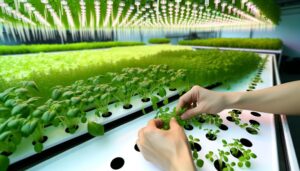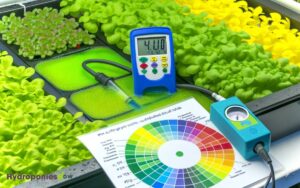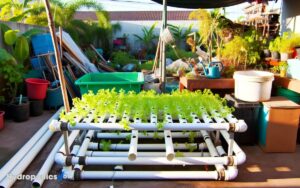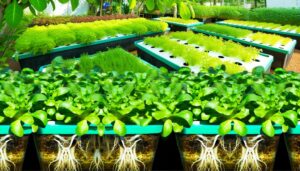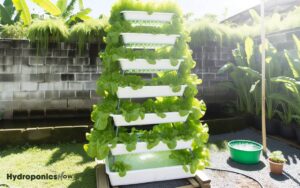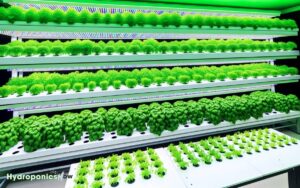Yes You Can Transplant Hydroponic Plants to Soil in 10 Steps
Yes, you can transplant hydroponic plants to soil by following a series of critical steps. Begin by gradually acclimatizing the plants, which includes reducing water levels and introducing nutrients found in soil.
Prepare nutrient-rich, well-draining soil with appropriate pH levels. Clean the roots thoroughly to remove any nutrient solution residues.
Plant the hydroponic system’s crops like leafy greens, herbs, tomatoes, and peppers, ensuring proper root placement and depth.
Consistent monitoring of soil moisture, nutrient balance, and plant health is essential to avoid transplant shock.
By adhering to these guidelines, you can guarantee a successful shift of your hydroponic plants to soil. Discover the nuanced practices for optimal outcomes.
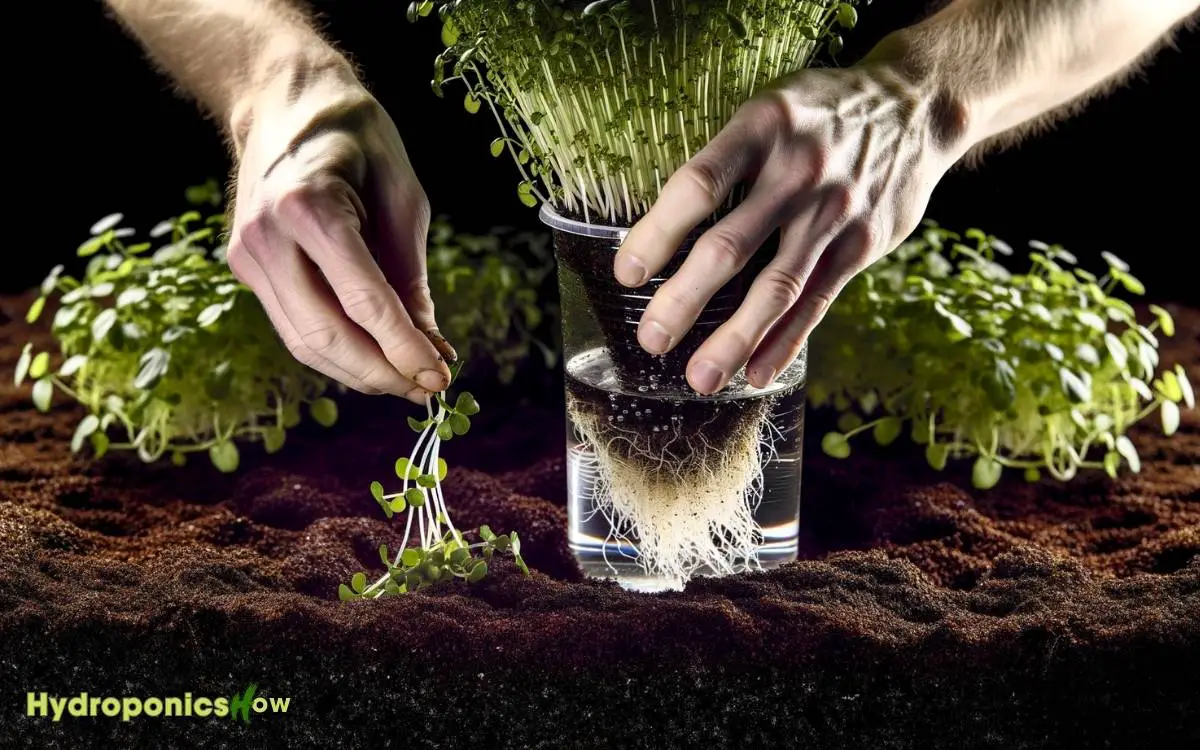
Key Takeaways
Understanding Hydroponic Systems
Hydroponic systems, frequently utilized in controlled environment agriculture, involve the cultivation of plants using nutrient-rich water solutions without the need for soil.
These systems employ various techniques such as nutrient film technique (NFT), deep water culture (DWC), and aeroponics to deliver essential nutrients directly to plant roots.
The absence of soil eliminates issues related to soil-borne diseases and pests, allowing for precise control over nutrient uptake. Key components include a reservoir for nutrient solution, a delivery system for distributing nutrients, and a support structure for plant stability.
Effective hydroponic management requires monitoring pH levels, electrical conductivity (EC), and nutrient concentration to ensure ideal plant growth. Understanding these fundamentals is vital for shifting hydroponic plants to soil environments.
Benefits of Transplanting
Transplanting plants from hydroponic systems to soil can offer the advantages of increased root structure stability, improved nutrient diversity, and greater accessibility to natural microbial ecosystems.
The transition allows roots to anchor more securely in soil, enhancing plant resilience. Soil’s complex nutrient profile offers a broader range of essential elements, promoting robust plant growth.
Additionally, the soil’s microbiome fosters symbiotic relationships, enhancing nutrient uptake and boosting plant health.
| Advantage | Explanation |
|---|---|
| Root Structure Stability | Enhanced anchoring in soil prevents plant toppling. |
| Nutrient Diversity | Soil provides a wider array of essential nutrients compared to hydroponics. |
| Microbial Ecosystems | Natural microbes in soil aid in nutrient absorption and disease resistance. |
| Resilience to Environmental Stress | Soil-grown plants often exhibit greater adaptability. |
| Cost-Effectiveness | Reduces need for synthetic nutrient solutions and maintenance costs. |
These benefits collectively contribute to more vigorous, sustainable plant development.
Selecting the Right Plants
When considering the shift from hydroponics to soil cultivation, it is imperative to select plant species that thrive in terrestrial environments and exhibit a robust adaptability to soil conditions. Plants with resilient root systems and versatility in nutrient uptake are ideal candidates.
Key species include:
- Leafy Greens: Varieties such as lettuce, spinach, and kale switch seamlessly due to their shallow root systems and high adaptability.
- Herbs: Basil, cilantro, and parsley are well-suited for soil transplantation, given their hardiness and minimal nutrient requirements.
- Tomatoes: Known for their vigorous root growth and capacity to adapt to soil, tomatoes are excellent choices.
- Peppers: With their robust structure and moderate nutrient demands, peppers adapt well to terrestrial cultivation.
Selecting these species ensures a higher success rate in the shift process.
Preparing the Soil
Properly preparing the soil is essential for the successful adaptation of hydroponic plants to a terrestrial environment. This process involves gradually introducing soil while ensuring adequate moisture and nutrients to support root development. If you ever decide to switch your plant to hydroponics, you’ll need to reverse this transition carefully to prevent shock. Maintaining optimal growing conditions during either change is key to a healthy and thriving plant.
Key considerations include ensuring the soil has adequate nutrient content, maintaining an ideal pH level, and providing sufficient drainage and aeration.
These factors collectively support root development and overall plant health, mitigating transplant shock.
Soil Nutrient Requirements
Guaranteeing ideal soil nutrient composition is crucial for the successful acclimatization of hydroponically grown plants moving from a hydroponic system to a terrestrial environment.
Adequate preparation involves:
- Macronutrients: Essential elements like nitrogen (N), phosphorus (P), and potassium (K) must be present in the right quantities to support plant growth and development.
- Micronutrients: Trace elements such as iron (Fe), manganese (Mn), and zinc (Zn) play critical roles in various physiological processes and must be adequately supplied.
- Organic Matter: Incorporate compost or well-decomposed organic material to enhance soil structure and provide a slow-release source of nutrients.
- Soil Amendments: Use lime or gypsum as needed to adjust soil texture and improve nutrient availability, ensuring optimal plant health and growth.
These steps secure a nutrient-rich medium conducive to robust plant development.
Proper Soil Ph
Achieving the ideal soil pH is crucial for the successful adaptation of hydroponic plants to soil, as it directly influences nutrient availability and microbial activity in the root zone.
Ideal pH levels generally range from 6.0 to 7.0, a slightly acidic to neutral environment where essential nutrients like nitrogen, phosphorus, and potassium are most accessible.
To measure soil pH accurately, use a soil pH meter or pH test kit. If the soil is too acidic (below 6.0), incorporate lime to raise the pH. Conversely, if the soil is too alkaline (above 7.0), sulfur or organic matter such as compost can help lower the pH.
Regular monitoring and adjustments maintain a conducive environment for plant growth and nutrient uptake.
Drainage and Aeration
Adequate drainage and aeration are imperative for the successful conversion of hydroponic plants to soil, as they prevent waterlogging and guarantee sufficient oxygen reaches the root zone.
Ensuring these conditions involves several critical steps:
- Soil Composition: Utilize a well-draining soil mix, preferably containing perlite, vermiculite, or coarse sand to enhance aeration.
- Container Selection: Choose pots with drainage holes to facilitate excess water expulsion, reducing the risk of root rot.
- Layering Technique: Implement a bottom layer of gravel or small stones in containers to improve drainage efficiency.
- Regular Monitoring: Continuously check soil moisture and adjust watering practices to maintain a balanced state, avoiding both dryness and saturation.
Proper preparation ensures the shift from hydroponic systems to soil is smooth and efficient.
Gradual Acclimatization
Gradual acclimatization is essential for hydroponic plants shifting to soil. Sudden changes in water availability, light intensity, and humidity levels can induce stress.
To guarantee a successful adaptation, it is vital to gradually adjust these environmental factors. Monitoring nutrient and pH levels is crucial to meet the plants’ evolving needs.
This systematic approach minimizes shock and promotes robust growth during the critical transformation phase.
Transitioning Water to Soil
To guarantee a successful shift from hydroponics to soil, it is crucial to gradually acclimate the plants by incrementally reducing their water exposure while simultaneously introducing them to soil-based nutrients.
This process ensures that the roots adapt efficiently to their new medium, preventing shock and promoting robust growth.
- Gradual Water Reduction: Slowly decrease the frequency and quantity of water provided to the plant over a period of one to two weeks.
- Nutrient Introduction: Begin incorporating soil-specific nutrients to the water to help the plant adjust to the different nutrient profile in soil.
- Partial Soil Mix: Start by mixing a small amount of soil with the hydroponic medium to familiarize the roots with soil texture.
- Monitoring Root Health: Regularly check the roots for stress indicators like discoloration or wilting and adjust the change pace accordingly.
Light and Humidity Adjustments
While acclimating hydroponic plants to soil, it is also important to adjust their light and humidity conditions to mimic the soil-based environment.
Hydroponic plants typically grow under controlled lighting and humidity, which may differ greatly from natural conditions.
Gradual acclimatization involves incrementally increasing their exposure to natural sunlight to prevent photoinhibition. Start by placing the plants in indirect light and gradually move them to areas with more direct sunlight over a week.
Concurrently, regulate humidity using a hygrometer, ensuring a gradual reduction in humidity levels to match typical soil conditions.
This controlled adjustment helps prevent stress-related issues such as leaf burn, wilting, or stunted growth, ensuring a smooth adaptation from hydroponic to terrestrial cultivation.
Nutrient and Ph Balance
Maintaining proper nutrient and pH balance is essential for the successful acclimatization of hydroponic plants to soil environments. Shifting requires methodical adjustments to guarantee plant health and vitality.
Gradually introduce soil nutrients and adjust pH to match hydroponic conditions to mitigate transplant shock.
Key steps include:
- Monitor pH Levels: Gradually shift soil pH to the plant’s preferred range, typically between 5.5 and 6.5, to avoid nutrient lockout.
- Nutrient Management: Introduce a balanced, diluted fertilizer to mimic hydroponic nutrient solutions, gradually increasing concentration.
- Root Acclimatization: Ensure roots are adequately rinsed of hydroponic media to facilitate nutrient uptake in soil.
- Watering Regimen: Adjust watering practices to suit soil, ensuring appropriate moisture levels to prevent root rot or dehydration.
Root Cleaning Techniques
Ensuring the successful conversion of hydroponic plants to soil is a meticulous process that requires thorough root cleaning. This essential step removes residual hydroponic nutrients and potential contaminants.
Begin by gently extracting the plant from its hydroponic system, taking care not to damage the root structure. Rinse the roots thoroughly under lukewarm tap water to eliminate nutrient solution residues.
Employ a soft brush to dislodge any stubborn particles clinging to the roots. Avoid using high-pressure water, which can cause root damage.
Inspect the roots for signs of disease or decay, trimming away any affected areas with sterilized scissors. This process not only prevents nutrient imbalances but also facilitates the plant’s adaptation to the new soil environment, promoting robust growth and development.
Planting Depth Guidelines
Accurately determining the appropriate planting depth is essential for the successful establishment of hydroponic plants in soil, as it directly influences root development and overall plant health. Proper planting depth guarantees ideal nutrient uptake and stability.
- Root Collar Visibility: Make sure the root collar, where roots meet the stem, is at or slightly above soil level to prevent rot.
- Root Spread: Spread roots horizontally in the planting hole to mimic their natural growth pattern and promote stability.
- Soil Loosening: Loosen the soil at the bottom of the hole to facilitate root penetration and water drainage.
- Compaction Avoidance: Avoid over-compacting the soil around the roots, which can impede oxygen exchange and root growth.
Following these guidelines will support the successful shift from hydroponics to soil.
Watering Requirements
Understanding the specific watering requirements for hydroponic plants shifting to soil is critical for preventing water stress and ensuring optimal growth conditions.
Initially, these plants have a high dependency on consistent moisture due to their hydroponic origins. Gradually acclimate them by maintaining soil moisture without waterlogging.
Employ a well-draining soil mix to prevent root rot and ensure oxygen availability. Monitor moisture levels by evaluating soil texture aim for a balance where soil feels damp but not saturated.
Utilize mulching techniques to retain moisture and reduce evaporation. Regularly adjust watering frequency based on plant response and environmental factors such as temperature and humidity.
Implementing these strategies will facilitate a successful shift from hydroponic systems to terrestrial growth environments.
Nutrient Management
Proper nutrient management is crucial for hydroponic plants moving to soil, as the nutrient availability and uptake mechanisms differ greatly between these two growing mediums.
Shifting requires guaranteeing the soil medium can meet the precise nutrient requirements previously controlled in a hydroponic setup.
Essential considerations include:
- Soil Composition: Choose a well-balanced, nutrient-rich soil that supports the specific needs of the plant species.
- Fertilization Schedule: Initiate a structured fertilization regimen that mirrors the hydroponic nutrient solution, gradually adjusting to soil-based uptake rates.
- Micronutrient Availability: Ensure the presence of essential micronutrients such as iron, zinc, and manganese, often abundant in hydroponics but variable in soil.
- pH Monitoring: Maintain ideal soil pH levels to facilitate nutrient absorption, similar to the controlled pH levels in hydroponic systems.
Following these steps ensures a successful nutrient shift.
Pest and Disease Control
Effective pest and disease control is paramount when moving hydroponic plants to soil, as the change can expose plants to new pathogens and pests not encountered in a controlled hydroponic environment.
To mitigate these risks, integrate a thorough Integrated Pest Management (IPM) strategy. This includes vigilant inspection for signs of infestation or disease, such as discolored leaves or stunted growth, and employing biological controls like beneficial nematodes or ladybugs.
Additionally, soil should be sterilized or sourced from reputable suppliers to minimize pathogen introduction.
Use fungicides and insecticides judiciously, adhering to organic options when possible. Regularly sanitize gardening tools and practice crop rotation to disrupt pest and disease life cycles. These measures will enhance plant resilience during the shift.
Monitoring Plant Health
Monitoring plant health post-transplantation necessitates a meticulous examination of root systems for signs of root rot. This can be indicated by brown, mushy roots.
Additionally, careful observation of leaf color is essential. Chlorosis or yellowing may signal nutrient deficiencies or transplant shock.
Implementing these practices guarantees early detection of potential issues, facilitating timely intervention and promoting peak plant health.
Check for Root Rot
To guarantee the successful shift of hydroponic plants to soil, it is paramount to meticulously examine the roots for any signs of rot, such as browning, mushy texture, or an unpleasant odor, which can indicate underlying health issues.
Root rot can severely compromise the plant’s ability to adapt to its new environment.
Follow these steps to guarantee healthy roots:
- Inspect visually: Look for discoloration or dark spots on the roots.
- Feel the texture: Healthy roots should be firm and white, not slimy or mushy.
- Smell for odor: A foul smell often indicates rot and bacterial growth.
- Prune affected areas: Trim away any diseased roots using sterilized tools to prevent further contamination.
This diligence ensures a robust shift from hydroponics to soil.
Observe Leaf Color
Observing leaf color is crucial for evaluating the overall health of transplanted hydroponic plants, as variations in hue can indicate nutrient deficiencies, water stress, or disease.
Chlorosis, or yellowing of leaves, often signifies nitrogen deficiency, while purplish hues may suggest phosphorus deficiency. Wilting or browning at the leaf margins could indicate potassium scarcity or water stress.
To accurately diagnose, compare leaf colors against standardized deficiency charts. Regularly inspect new growth, as initial signs of imbalance generally manifest in young leaves.
Implement corrective measures promptly, such as adjusting nutrient solutions or improving soil drainage.
Consistent monitoring and timely intervention not only mitigate potential setbacks but also ensure the robust adaptation of hydroponic plants to their new soil environment.
Common Mistakes to Avoid
One common mistake to avoid when transplanting hydroponic plants to soil is failing to properly acclimate the plants to their new environment, which can result in transplant shock and hinder growth.
Proper acclimatization requires a gradual introduction to soil conditions and environmental changes.
To guarantee successful transplantation, avoid these common errors:
- Insufficient Root Cleaning: Failing to thoroughly rinse hydroponic media from roots can introduce pathogens.
- Inadequate Soil Preparation: Using compacted or nutrient-poor soil can impede root growth and nutrient uptake.
- Improper Watering Practices: Overwatering can lead to root rot, while underwatering can cause dehydration.
- Neglecting pH Adjustment: Soil pH should be adjusted to match the plant’s ideal range to avoid nutrient deficiencies and toxicities.
Following these guidelines will help mitigate potential issues and promote healthy plant development.
Conclusion
The conversion of hydroponic plants to soil necessitates a thorough understanding of hydroponic systems and careful preparation of the soil to guarantee successful acclimatization.
By meticulously managing nutrients and vigilantly monitoring plant health, one can mitigate potential pest and disease challenges.
Adhering to best practices and avoiding common errors will facilitate robust plant growth.
This endeavor, though requiring meticulous attention, can yield gratifying results, enhancing horticultural versatility and resilience.

